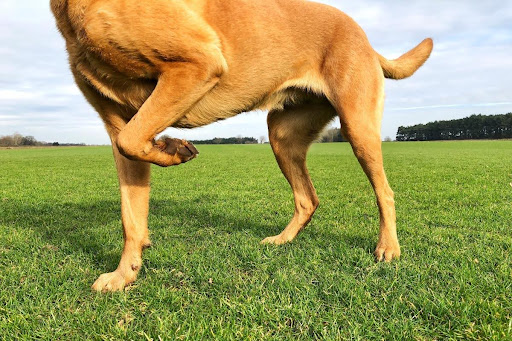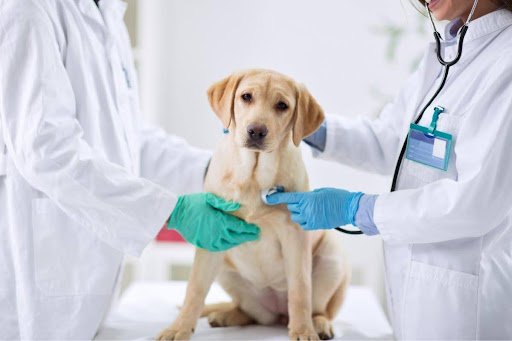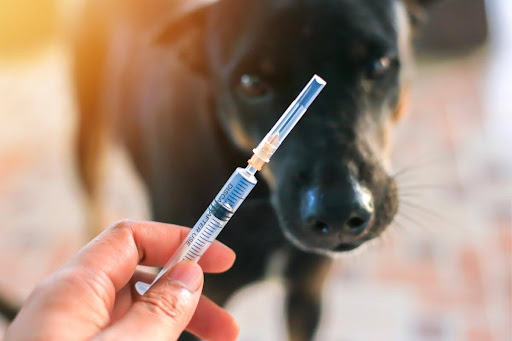Did you know that osteoarthritis (OA) isn’t just something that affects older dogs? It’s actually a huge deal, impacting a whopping 80% of dogs over eight years old and even up to 35% of dogs of all ages. From the playful Labradors to the sweet Golden Retrievers OA is the number one cause of chronic pain in dogs and it’s not just a ‘senior dog’ problem but a concern for all dog lovers.
Imagine your usually active and happy pup starting to slow down, not just because of age but due to OA. This isn’t a rare condition tucked away in a corner – it’s widespread and affects millions of dogs globally.
In this article, we will explore osteoarthritis in detail, its symptoms, causes, and advanced treatment options. Keep reading to discover how you can be the hero your dog needs, turning their silent struggles into a journey of comfort and care.
What Is Osteoarthritis in Dogs?
Osteoarthritis in our furry friends, often called Degenerative Joint Disease (DJD), is unfortunately a common and painful condition that many dogs face. This troublesome ailment primarily affects their joints, leading to a gradual breakdown of the cartilage that’s so crucial for cushioning and protecting these important areas. It’s kind of like losing the shock absorbers in a car – things start to get a bit bumpy and uncomfortable!
- Nature of the Disease: Here’s the deal with this tricky condition: In a healthy joint, cartilage is the superstar that allows smooth and flexible movement. But when osteoarthritis steps in, this protective cushion begins to wear away over time. Imagine a comfy sofa slowly losing its fluffiness – that’s what’s happening in your dog’s joints. This loss leads to inflammation and pain, and it makes it harder for your dog to move around as freely as they used to. Sometimes, the joint even develops bone spurs, which are as uncomfortable as they sound.
- Common Sites and Susceptibility: Now, osteoarthritis can sneak up in any joint, but it’s particularly fond of targeting your dog’s limbs and lower back. It’s more common in older dogs, larger breeds, athletic pups, and working dogs. But don’t think puppies are safe; conditions like elbow or hip dysplasia can make them vulnerable to early-onset osteoarthritis.
- Progression: One of the sneaky things about osteoarthritis is how silently it can progress. Since cartilage doesn’t have nerves, the early signs can be really hard to spot. That’s why it’s super important to keep an eye out for signs like limping, stiffness, or a decrease in their usual playfulness. If you notice any of these, it’s time for a trip to the vet. They’re the best at diagnosing and suggesting treatment options.
Risk Factors for Osteoarthritis in Dogs
Osteoarthritis (OA) in dogs can affect any breed, but certain factors can increase a dog’s susceptibility to this condition. Understanding the risk factors can really help in keeping your pup happy and healthy. Here’s what you need to know:
- Breed Matters: Some larger breeds, such as German Shepherds, Labrador Retrievers, Golden Retrievers, and Rottweilers, are more likely to develop OA. It’s partly because of their size and weight – more of them to love means more stress on their joints.
- Age Is Not Just a Number: As our pups enter their golden years, their chances of developing OA increase. It’s like the joint wear-and-tear adds up over time. So, older doggos need a bit more TLC (tender love care)!
- Watch the Waistline: Obesity is a big no-no. Extra pounds mean extra pressure on those precious joints, speeding up wear and making them prone to OA. Keeping your pup fit is key!
- Active Lifestyle, Active Risks: Dogs who love high-impact activities (think agility sports) or those who’ve had injuries are at a higher risk. It’s like their joints have had a tougher workout over their lifetime.
- Joint Health History: If your dog has had issues like hip or elbow dysplasia, or any joint injuries, they’re more likely to get OA.
- It’s in the Genes: Some pups are born with joint conditions or not-so-perfect joint development, thanks to their genetics. These guys need extra attention to keep OA at bay.
- Infections and Nutrition: Nasty infections like Lyme Disease or not getting the right nutrition can also nudge your dog towards OA.
Symptoms of Osteoarthritis in Dogs
Recognizing the symptoms of osteoarthritis in dogs is important for early intervention and effective management. It’s like being a detective in your dog’s world – the clues are there, and it’s up to us to piece them together. Here’s what to keep an eye out for:
- Movement Challenges: If your dog is moving like they’re in slow-mo, it’s time to pay attention. Look for stiffness, limping, or a reluctance to run, jump, or climb stairs. It’s like they’ve lost their usual spring. And if you notice a slow, shuffling walk, that’s a big clue.
- Joint-related Signs: Keep an eye on those joints. Swelling is a red flag. If your furry friend is licking their joints a lot, it’s probably not just for cleanliness; they could be in pain. Also, a clicking sound when they walk? That’s your cue to check in with the vet.
- Behavioral Changes: Dogs can’t tell us they’re in pain, but they sure can show it. If your dog suddenly seems as enthusiastic about walks as a cat does about swimming, it’s a sign. Watch for restlessness, difficulty getting comfy, or changes in personality like being withdrawn or grumpy.
- Physical Evidence: If your active dog is suddenly packing on the pounds, or if their muscles look like they’ve been skipping gym day, it’s a hint. Osteoarthritis can make moving tough, leading to weight gain or muscle loss. And if your house-trained buddy starts having accidents, it could be because moving is just too painful.
- Subtle and Late-Stage Symptoms: In the beginning, the signs of osteoarthritis can be sneaky – maybe your dog is just a bit more tired than usual. But as things progress, the evidence becomes clearer, like showing pain when you give them belly rubs or struggling with car rides.
Remember, our middle-aged to senior doggos are the usual suspects for this condition. If you spot any of these signs, it’s time to call in the experts – your vet.
Osteoarthritis Diagnosis in Dogs
If you’ve spotted any of the symptoms we talked about earlier, the next step is a trip to the vet. Here’s what happens in the vet’s detective lab:
- Joint Evaluation: First up, the vet gently feel each joint (palpation) to check for any discomfort and see how well they can move. It’s like giving each joint a mini-physical exam!
- Fluid Accumulation Check: Next, they’ll check for any sneaky fluid build-up around the joints. If they find any, they might take a sample to see what’s going on in there.
- Muscle Atrophy Inspection: Especially in older dogs, the vet will check for muscle atrophy (muscle loss). It’s a big hint that OA might be lurking around.
- Radiographic Imaging: X-rays are the superheroes here, revealing the hidden world of your dog’s bones and joints. They show changes like bone spurs or narrowing joint spaces that scream “OA is here!”
- Advanced Imaging Techniques: Sometimes, the vet needs to go deeper. That’s where MRI or CT scans come in to see more details of joint changes and cartilage health.
- General Health Overview: Often, they’ll do bloodwork and urine tests, especially for senior dogs. It’s like getting a full health report card to see how everything else is doing.
Treatment of Osteoarthritis
Dealing with Osteoarthritis (OA) in our furry friends can be challenging, but don’t worry, there are some really effective ways to help them feel better! While OA is a condition that progresses over time and can’t be reversed, the good news is that with the right care, we can significantly improve our dogs’ comfort and quality of life.
First off, let’s talk about a super exciting development – the U.S. FDA has given the thumbs up to Librela, a special kind of medication called a monoclonal antibody, designed just for dogs. This is a big deal because it’s specifically made to help control the pain associated with OA. It’s always great to see such innovative treatments becoming available for our four-legged pals!
Pain Management and Anti-Inflammatory Medications
Now, when it comes to managing OA pain, veterinarians often turn to a group of medications called non-steroidal anti-inflammatory drugs (NSAIDs). You might have heard of some of them, like meloxicam, carprofen, and firocoxib. These are usually the go-to choices and are picked based on each dog’s specific needs.
In some cases, especially if a dog can’t take NSAIDs, vets might prescribe corticosteroids. But remember, it’s a no-go to use them at the same time as NSAIDs. Another option for our older furry friends, or those who might not handle NSAIDs well, is gabapentin. This helps manage chronic pain really well.
Sometimes, vets might mix and match medications for the best results. They might use other less common meds like tramadol, amantadine, or even acetaminophen. But it’s super important to remember that we should never use our own medicine stash for our dogs. Their treatments should always come from their vet.
Librela: A New Dimension in Pain Management for Osteoarthritis in Dogs
Librela contains a special ingredient called bedinvetmab, which is like a targeted ninja that blocks a pain-inducing protein called nerve growth factor (NGF). NGF is a big deal in how dogs feel pain from OA, and by blocking it, Librela helps stop those pesky pain signals from reaching your dog’s brain. This means more comfort and wagging tails!
Administering Librela is pretty straightforward – it’s a once-a-month subcutaneous injection, which simply means it goes under the skin. The amount given depends on the dog’s weight, ensure a minimum dose of 0.5 mg per kg of the dog’s body weight. But remember, Librela is a prescription-only medication, so you’ll need to consult with your vet about it. They’re the best go-to for making sure it’s the right fit for your dog.
Like all medications, Librela can have some side effects. These might include things like changes in blood urea nitrogen levels, urinary tract or skin infections, skin irritation, rashes, or discomfort at the injection site. Some dogs might also experience vomiting or weight loss.
It’s really important to talk with your vet about these possibilities so you know what to watch for and can keep your dog safe and comfortable.
Exercise and Physical Activity
Just like for us humans, regular and suitable exercise is super important for dogs with OA. It’s not about how much exercise, but more about the right type of exercise to keep them fit, control their weight, and ease any joint discomfort. Think of it like a personalized workout plan for your dog, often designed with your vet’s advice.
Dietary Management
Keeping an eye on your dog’s diet is key in managing OA. Extra pounds can really put a strain on those joints, so maintaining a healthy weight is crucial. Vets often recommend specific diets that support joint health and help manage weight. It’s like having a nutritionist for your dog, ensuring they get exactly what they need for their condition.
Physical Rehabilitation and Alternative Therapies
There’s a whole world of additional treatments that can do wonders for dogs with OA. It’s like physical therapy but for pets! Techniques borrowed from human physiotherapy, like therapeutic laser treatments, specialized exercises, joint mobilization, and even hydrotherapy (think underwater treadmill sessions!), can really help.
Plus, alternative options like medical acupuncture, chiropractic care, and medical-massage offer additional avenues for pain relief and improved mobility.
Joint Supplements
Nutraceuticals, like glucosamine, chondroitin, omega-3 fatty acids, and polysulfated glycosaminoglycans, are often included in OA management. These aren’t just any supplements; they’re specially chosen for their medicinal benefits to support joint health. They can be a big help in both early and ongoing management of OA. However, it’s always best to chat with your vet about these to ensure they’re the right choice for your furry friend.
Surgical Interventions
Sometimes, OA can get pretty tough, and when it does, surgery might be an option. This isn’t just any surgery – we’re talking about high-tech procedures like total hip replacements, or even specialized surgeries like femoral head/neck ostectomy (FHO) and joint arthrodesis.
In some cases, vets might even consider elbow or knee replacements. The decision to go for surgery depends on a few things like how severe the OA is, your dog’s age, weight, and overall health. It’s all about finding the best way to make your furry friend comfortable and pain-free.
Osteoarthritis Recovery in Dogs
Dealing with OA is a journey, but it’s not the end of the road to a happy dog life. With the right treatment and care, many dogs live comfortably for years after being diagnosed. Keeping an eye on their weight and sticking to the vet’s advice, including regular blood checks, is key.
And if surgery is needed, you’ll be amazed at how well dogs can bounce back – most of them are up and about, doing their doggy things, within six months after something like a joint replacement. Just remember to follow your vet’s post-surgery care instructions closely.
Conclusion
If you love dogs or are thinking of bringing one into your life, understanding OA is really important. But remember, it doesn’t have to be a downer. Early detection, the right treatment, and consistent care can make a world of difference. Whether you’re managing their diet, exercise, medications, or even considering surgery, you have a huge role in your dog’s health and happiness.
Being an informed and responsible dog parent is so rewarding. With your love and care, your dog can lead a joyful life, even with OA. Let’s make a promise to give our furry pals the best life possible – full of love, comfort, and, of course, those happy tail wags! 🐾❤️
Let us show you some more gentle training methods where you can still keep your pup active and healthy!
972-372-9225




